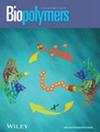On the Architecture of Starch Granules Revealed by Iodine Binding and Lintnerization. Part 2: Molecular Structure of Lintnerized Starches
Abstract
This investigation validated iodine binding in combination with lintnerization for studying the structural nature of the amorphous areas in starch granules. Lintners of four iodine vapor-stained and non-stained amylose-containing starches and their waxy counterparts were analyzed by high-performance anion-exchange chromatography (HPAEC). The composition of the lintners was strongly affected by the absence of amylose in barley and potato starch but not in maize and cassava starch. Iodine-stained waxy lintners possessed increased number of long B2 chains. β-Limit dextrins of the lintners were very variable in composition. Iodine inclusion complexes washed out from the granular residues in the lintners (mostly from amylose-containing barley and maize starches) were also analyzed. Acid-soluble complexes from both amylose-containing and waxy starches possessed a lot of material with a degree of polymerization (DP) around 60 and a periodicity in size of DP 8–12. Such long chains were only minor components in water-soluble complexes of amylose-containing barley and maize starch lintners, and they lacked the size periodicity. Models of the principal structure of the acid and water-soluble complexes are suggested. It is concluded that acid hydrolysis of iodine-stained starch granules is a useful tool in structural analyses of the molecular composition of amorphous parts of starch granules.


 求助内容:
求助内容: 应助结果提醒方式:
应助结果提醒方式:


